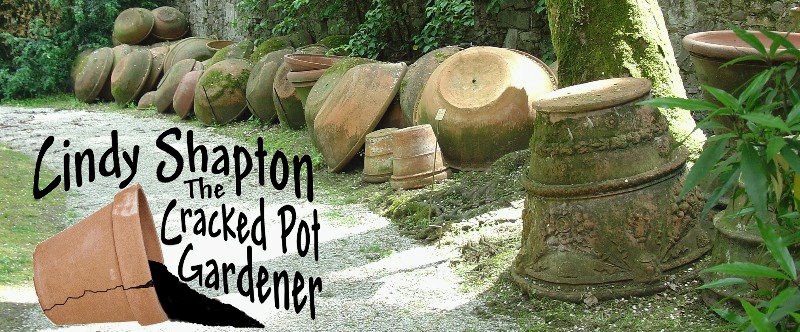 Annie, the garden dog and I like to head out early to beat the heat and enjoy the quiet of the morning in the garden. No time to fix a proper breakfast, we girls usually just forage. This morning Annie and I enjoyed ripe blackberries still covered in dew as we watered and pulled weeds. Annie likes to pick the low ones.
Annie, the garden dog and I like to head out early to beat the heat and enjoy the quiet of the morning in the garden. No time to fix a proper breakfast, we girls usually just forage. This morning Annie and I enjoyed ripe blackberries still covered in dew as we watered and pulled weeds. Annie likes to pick the low ones.We or I should say (Annie won’t eat greens) I followed that up with purslane, a green that is often confused with a weed. Well, okay it is considered a weed in the real world but here at “The Wheel is Off the Bus” Garden (my pet name for my gardens for 2010), purslane is growing happily in the herb garden and even in pots handy to the kitchen so I don’t have to travel far to harvest some.
 Purslane, Portulaca oleracea, an earth hugging succulent that has reddish thick, water filled stems and fat paddle shaped ½-2” leaves. According to “Wildman Steve Brill” Purslane was once a food crop in India. I have no idea how it got here but it grows freely in meadows, lawns and gardens. It loves hot dry weather and doesn’t skip a beat in our southern growing conditions.
Purslane, Portulaca oleracea, an earth hugging succulent that has reddish thick, water filled stems and fat paddle shaped ½-2” leaves. According to “Wildman Steve Brill” Purslane was once a food crop in India. I have no idea how it got here but it grows freely in meadows, lawns and gardens. It loves hot dry weather and doesn’t skip a beat in our southern growing conditions.You can find purslane growing from spring through fall. It blooms a yellow flower with 5 petals and one plant can have 50 thousand teeny, tiny seeds which are edible and viable for up to 30 years if undisturbed.
If identification is unclear, break open a stem, if it exudes a white milky sap it could be a poisonous spurge plant warns Brill which sometimes grows nearby. Purslane stems are filled with water. In fact, if you are weeding purslane, remove the plant from the garden as the water in the stems keeps the plant alive so it can quickly form seeds to disperse in an effort to pro-create. How cool is that?
The stems and leaves can be steamed, sautéed like spinach, eaten raw in salads, rolled in tortillas or chopped and added to soups for a thickening agent much like okra. In Russia folks dry and can this green.
Filled with Omega-3 fatty acids, vitamin C, beta-carotene, calcium, magnesium, potassium and iron, purslane is a healthy foodstuff that may lower cholesterol and blood pressure and help with joint inflamation. The best news is it grows wild. Good to know if you are out early and need something good to eat for breakfast!


 The Vegetable garden in general needs about an inch per week to maximize production and prevent problems like splitting tomatoes. Soaker hoses or drip irrigation are better than overhead methods. However if you have only sprinklers to work with water in the mornings so the leaves have plenty of time to dry out and water for a longer period of time every 4-7 days (depending on temperatures and drying winds) rather than a little every day. The plants will appreciate the longer less frequent drinks and their roots will grow deeper into the earth making them more sustainable and stronger when the heat gets turned up or winds knock them about.
The Vegetable garden in general needs about an inch per week to maximize production and prevent problems like splitting tomatoes. Soaker hoses or drip irrigation are better than overhead methods. However if you have only sprinklers to work with water in the mornings so the leaves have plenty of time to dry out and water for a longer period of time every 4-7 days (depending on temperatures and drying winds) rather than a little every day. The plants will appreciate the longer less frequent drinks and their roots will grow deeper into the earth making them more sustainable and stronger when the heat gets turned up or winds knock them about.
 Meet the latest addition to the coop, Cilantro and Coriander. It took these chicks a while before I named them or even decided if they could stay. A couple of times I’ve threatened to let them fly back home to Louisiana where my son got them. For a while now I’ve simply referred to these girls as the evil twins. A name they earned shortly after moving in with Cornbread and Taco.
Meet the latest addition to the coop, Cilantro and Coriander. It took these chicks a while before I named them or even decided if they could stay. A couple of times I’ve threatened to let them fly back home to Louisiana where my son got them. For a while now I’ve simply referred to these girls as the evil twins. A name they earned shortly after moving in with Cornbread and Taco.






